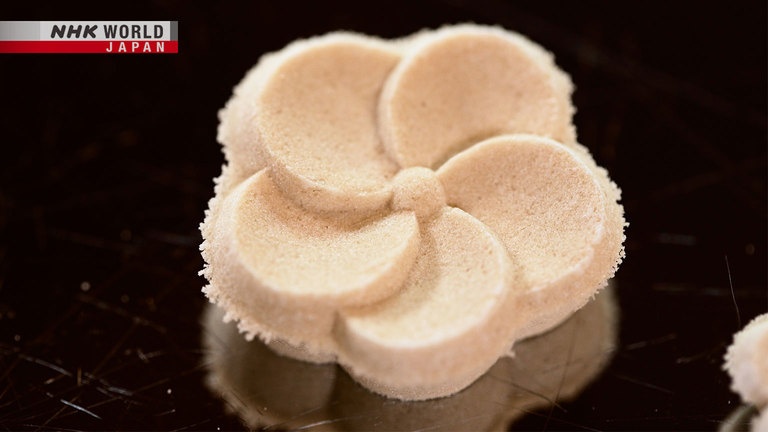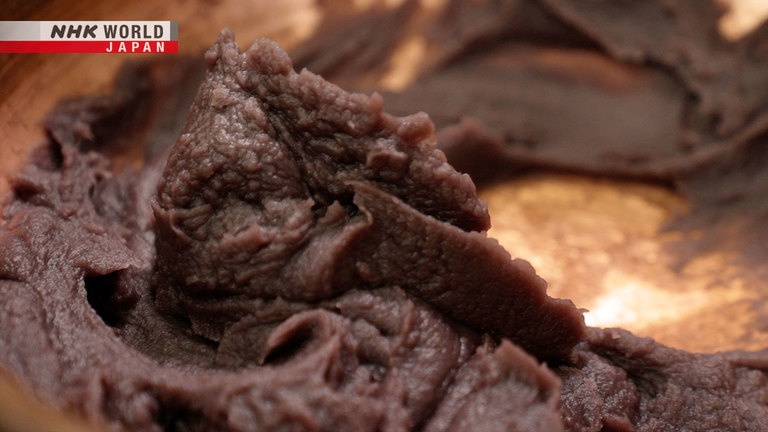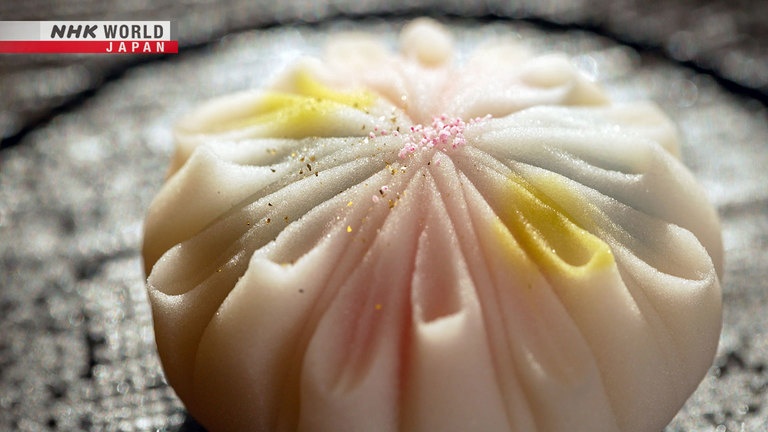Cook Around Japan - Kanazawa: Tradition Thrives by Innovation
Meet traditional yet innovative artisans in Kanazawa. This is a story of people constantly breathing new life into historical food culture, connecting the past to the future.
(1) Rakugan - a Colorful Molded Confection

Ingredients
Japanese traditional refined sugar (Wasanbon)
Glutinous rice flour
Sugar syrup
Directions
1. Mix wasanbon sugar, flour and syrup well and knead mixture until sticky.
2. Pack the dough into a mold dusted with flour to prevent it from sticking.
3. Carefully remove the sweets from the mold and let them dry naturally.
(2) Anko - Red and White Simmered Bean Sweet Paste

Ingredients
Red beans (Azuki)
Crystal sugar (Zarame)
Directions
1. Rinse the beans and bring to a boil in a pot. Once it boils, add the water to maintain the temperature below 50℃. Repeat boiling and cooling, three times.
2. Reduce the heat to low and simmer until the beans are softened. Remove the white foam that appears on the surface while simmering. Allow them to cool slowly by adding a trickle of water.
3. Drizzle water over the beans while straining, and set aside for 15 minutes so that only the starch is allowed to settle. Discard the liquid and press through a fine mesh strainer and repeat the process for five times.
4. Squeeze out the excess water using a fine mesh cloth.
5. Melt the crystal sugar and combine with the prepped azuki (red beans) in a pot, knead slowly over low heat until it has a silky smooth texture.
(3) Jonamagashi - High Grade Confections, for Every Season

Ingredients
Anko (Red and white simmered bean sweet paste)
Neri-kiri (Sweetened, simmered white kidney bean paste and steamed mochi rice mixture)
Gold leaf for decoration
Directions
1. Wrap the red bean anko with the neri-kiri dough and shape as you like.
2. Make a dent in the center and add various types of colored white bean paste to create a gradation.
3. Design as you like, using a stick to carve out a shape and pattern. For an elegant touch you can sprinkle gold leaf onto the Jonamagashi.
Transcript
Dining With the Chef!
Welcome to Cook Around Japan, I'm your host Yu Hayami.
Today I'm visiting Kanazawa in Ishikawa Prefecture.
I'm standing in the middle of historical site.
This is the old Samurai District where samurai and their families used to live.
This area is one of Kanazawa's many historical districts.
It's a city where you can still experience the atmosphere and lifestyle of old Japan.
This sets it apart from Tokyo, making it a popular destination for overseas travelers.
Kanazawa is also famous for its rich culture and sophisticated food culture.
So, join me today as we explore Kanazawa's traditional cuisine.
Let's explore Japanese cuisine in greater depth.
Japan is a chain of islands approximately 3,000 km long from north to south.
There's a large variation in climate, and the terrain in each region has given rise to a diverse culture of food.
Our destination today, Ishikawa Prefecture in Hokuriku, northwestern Japan.
The capital, Kanazawa, was one of the more powerful castle towns in feudal Japan, dating back to around 1600.
Its tranquil and refined beauty makes it a popular destination for seasoned travelers.
With access to the bounties of the Sea of Japan and fertile inland fields,
Kanazawa is famous for its food, as well as its exquisite arts and crafts.
Its traditions and culture have evolved in the hands of successive generations.
Oh, this is so pretty.
Welcome to Cook Around Japan: Kanazawa.
A city where tradition thrives by innovation.
Kanazawa is a castle town that was built by feudal lords' samurai some 450 years ago.
Many of its traditional arts and crafts continue to flourish.
One example is Kutani ware, which has been designated an Intangible Cultural Property.
Wow.
They kept beautiful design on the dishes.
Very colorful and so elaborate.
Kutani ware is a type of porcelain, that has been produced in Ishikawa Prefecture from the mid 1600s.
Various styles exist, including pieces featuring fine elaborate patterns and beautiful gradations of color.
This store was established, around two centuries ago and deals in all kinds of Kutani ware.
So what would you say is the most traditional Kutani Yaki design of all?
The best-known designs depict nature,
including birds, flowers, and scenery.
These were the very first kutani designs.
There are five dominant colors:
red, blue, yellow, green, and purple.
Plus gold and silver.
Artists blend these colors to create
lighter or stronger hues.
The production of Kutani ware began in the 17th century.
The feudal lord of the domain, was a patron of culture and arts,
gathering artists and artisans from all over Japan.
This led to the development of Kutani ware.
Today, Kutani ware remains a representative art form of Japan and is a popular choice as a gift.
In addition to the business aspect of Kutani ware, this store also has its own studio
where young aspiring potters work hand in hand with skilled artisans producing porcelain.
These are the works of young potters.
For 370 years, we stuck to
recreating traditional designs.
But we decided to give free rein to young potters.
They came up with interesting designs
like this sea horse.
Traditional Kutani ware techniques, have inspired the creation of innovative designs and patterns.
So Kutani Yaki, I understand, is a very traditional method of creating the pieces.
But here I see that you have created modern designs?
Yes, and that's part of the craft.
New designs, suited to the times,
have been produced for 370 years.
And using modern designs
makes dining fun.
Kutani ware continues to evolve along with culinary lifestyles.
It pursues innovation while preserving tradition.
Through this evolution, Kanazawa protects its historic crafts.
And, that same blend of tradition and innovation is present in the local cuisine.
This Japanese-style restaurant was founded around 1830.
During the feudal period, this region was called Kaga.
Its traditional cuisine still bears this name.
Kaga cuisine is a synergy of
craftsmanship such as Kutani ware.
It's a comprehensive art form.
Exquisite food, prepared with choice ingredients from the sea and fields
is presented on stunning pieces of Kutani ware, which are themselves works of art.
The feudal lord of the Kaga domain, would entertain his guests with Kaga cuisine.
This restaurant was established by a chef who served the lords of the domain,
which means the traditional dishes and customs of the time have been handed down through generations.
Each dish reflects the spirit of the samurai.
Kaga cuisine is the food enjoyed
by the lord and his peers.
This steamed seabream is
stuffed with "okara" soybean pulp.
It's cut along the back.
This is because cutting open
the stomach would imply "seppuku."
The ritual suicide of the samurai.
The restaurant also serves a more modern and casual menu, that retains the essence of Kaga cuisine.
We want young people to
appreciate Kaga cuisine.
So we're doing what we can
to keep the tradition alive.
During the Edo period, this was one of Kanazawa's largest entertainment districts, with many restaurants and tea houses.
It still retains much of its former glory and draws many tourists, who enjoy the feeling of stepping back in time.
This historic Japanese sweet shop is said to have been founded in 1625.
Oh this is just so peaceful and I just love the whole presentation of this very simple and yet so beautiful.
This is a "Jonamagashi," a fresh seasonal sweet, that is served with strongly brewed matcha.
It's so beautiful, so detailed.
Beautiful, look at this.
It's sweet, but not too sweet.
It has a very elegant taste to it.
I'm just in all of the beautiful presentation and the decoration.
Smells so nice.
Ah so nice.
That just brings me pure joy. It's really really nice.
So is Japanese confectionery a very big part of Kanazawa culture?
Yes, Kanazawa is the largest consumer
of Japanese sweets in Japan.
Western sweets, too.
So everyone has sweet tooth.
Yes, Kanazawa is famous for its sweets.
The feudal lords of the domain
nurtured their development.
Exquisite sweets were sent as gifts.
And out of respect for their lords,
the public adopted the custom.
That's why they're such
an integral part of our culture.
Kanazawa's sweets played a role in the politics of the feudal lords.
Kanazawa was a large and wealthy domain,
so it was the target of jealousy.
To avoid confrontation, the lords spent
their wealth on artistic pursuits.
This included the development of sweets
associated with the tea ceremony.
Sweets helped to foster social and political relations.
Sugar was a delicacy, so sending gifts
of sweets made for amicable relations.
Tea gatherings served a vital purpose
in feudal Japan.
They provided opportunities to
meet privately with people of power.
Kanazawa's sweets helped to boost the
reputation of the lords of the domain.
Records show they were
frequently invited to tea gatherings.
This shop was founded around 1625, as the exclusive confectioner for the lords of Kanazawa.
The utensils and molds, handed down together with the techniques are valuable records of Kanazawa's history.
Nakamiya Chisato, is the 19th-generation manager of this shop.
In Japan, it is rare for a manager of a shop like this to also be an artisan, but Nakamiya is an exception.
While working as a confectioner, she realized the importance of the ingredients used in Japanese sweets.
She insists on using time-honored ingredients.
We use the same ingredients
as they did in the Edo period.
We supplied sweets of utmost quality to the lords.
This called for the use of premium ingredients.
It's important not to compromise on quality.
The ingredients are part of our history.
If we stop using them, our culture would be lost.
One such ingredient is kudzu powder, a solidifying agent in sweets.
Made by extracting the starch from the roots of the kudzu vine,
kudzu powder is one of the oldest ingredients used in traditional sweets and high-end Japanese cuisine.
Nakamiya insists on using kudzu produced in a small town about an hour's drive from Kanazawa.
400 years ago, the town's producers began supplying high-quality kudzu to the shoguns.
I've never compared "Hodatsu kudzu"
to that of other regions.
But I'm confident that
our water is the best.
For generations, the producer has supplied Nakamiya's family with exclusive hand-made kudzu powder.
We cannot discontinue
our ancestor's legacy.
Just like Nakamiya's confectionery
we have over 380 yeras of history.
We have a lot in common.
Traditions like confectionery and
local crops are the legacy of the lords.
And we share a belief in the
importance of keeping them alive.
So, there's a strong bond between us.
The confection we're making today is among Kanazawa's oldest and most famous.
The shop began making them about 380 years ago.
They were selected as one of the top three confections of the Edo period.
"Rakugan" calls for a fine,
premium grade sugar called "wasanbon."
This is mixed with locally produced
glutinous rice flour.
- Also, some sugar syrup.
- I see. That's why it's a little sticky.
The "rakugan" mixture is kneaded until sticky.
Oh, I can see it changing, like the texture.
It's getting to be very smooth, very paste-like.
The dough is then packed into a mold dusted with flour to prevent sticking.
These wooden molds are very precious.
Only a handful of artisans
are allowed to handle them.
Dust off the excess flour and carefully remove the sweets from the mold.
- And you have a batch of "rakugan."
- Oh, look how pretty!
They're still very soft. So we allow
them to dry naturally until hardened.
Because the sweets are so simple, they require premium ingredients for good flavor.
It's just mind-blowing to think that 300 or 400 years ago,
this was eaten by the lords and people overall. It's amazing.
Yu gets to try her hand at making "rakugan."
Is it okay? Are we done?
Yes, but be careful when
removing them from the mold.
Okay, 1, 2, 3!
Perfect!
See? Very good teacher!
- Thank you.
- Oh, this is so pretty!
Another essential ingredient in Japanese sweets is "anko": red bean paste.
"Anko" is made by kneading red azuki beans with sugar.
Let's see the traditional method.
At first, it resembles the approach you'd use at home.
Rinse the beans thoroughly.
Add water and bring to a boil.
Then, add more water.
Adjusting the water temperature
allows the beans to swell.
Preboil the beans to remove any unpleasant flavor,
adjusting the temperature to keep the beans from bursting open.
Lower the temperature below 50°C.
It should be cool enough
to stick your finger in.
Once it cools, scoop off the water, leaving just enough to cover the beans.
Then, return to a boil.
Discard any beans that float
to the surface.
It means they're stunted or bug-eaten.
It's the same with rice.
After repeating the process of boiling and cooling three times,
simmer carefully to prevent the loss of umami flavor.
See how smooth and plump the beans are?
Parboiling to this level is proof of craftsmanship.
It determines the flavor of the "anko."
After parboiling, reduce the heat to low and simmer while removing the white foam that appears on the surface.
Simmer until they can be
easily crushed, like this.
Once the beans are softened, allow them to cool slowly, by adding a trickle of water.
From this point, we'll see the top level craftsmanship used to make premium "anko."
Now for the straining process, essential for making a silky-smooth "anko."
Pour the cooled beans into a strainer and press.
Trickle water over the beans while straining.
After straining, set aside for 15 minutes so that only the starch is allowed to settle.
Discard the liquid and press through a fine mesh strainer.
This process is essential in the making of a smooth and pure "anko."
Repeat five times until smooth, then squeeze out the excess water using a fine mesh cloth.
This is still just the prepping stage of the "anko."
Only 500 grams of "anko" can be produced from 1 kilogram of azuki beans.
It is the highest and purest quality "anko."
Melt the crystal sugar and combine with the prepped azuki.
Knead slowly, over low heat, to produce the smooth "anko" required for premium Japanese confections.
This smooth "anko," is used to make fresh seasonal sweets called "Jonamagashi."
A smooth paste made from white kidney beans is mixed with glutinous rice flour,
to make a dough called "nerikiri," which is used to wrap the "anko."
I'm going to make a sweet
inspired by fireworks.
Indeed, fireworks are part and parcel of summer in Japan.
She wraps the "anko" with "nerikiri" dough.
It's so pretty. I wonder what's gonna look like.
Using miniature tools, she carves out a shape and pattern.
Interesting. Oh my goodness. Look at that.
Now for some tiny petals.
Finally, a sprinkling of gold leaf.
Yu is going to make something different, using the same ingredients.
Oh, that's so fun!
Oh, I love it. This is very nice.
Yes, so pretty. And here is my version of traditional Japanese confectionery.
"Jonamagashi."
Yu's wonderful design is the image of a hydrangea blossom.
Oh look, how pretty!
Mm. Oh I love this...
The white bean paste and the red bean paste.
It's so sweet, but it's so elegant and it's not overly sweet. It's just the right amount.
The ingredients are all plant-based,
so it leaves a clean aftertaste.
I am just in all of today's experience, not only with the sweets delicious,
but I was able to learn so much about the culture behind the Japanese confectionery.
So thank you so much.
Kanazawa's traditional culture continues to thrive by innovation.
Nakamiya, the artisan and manager of her family's historic business, is constantly pursuing new ideas.
We must keep this 400-year tradition
relevant in the future.
It seems we have our work cut out for us.
But we can be sure to
work diligently, every day.
And that way,
I believe we can make history.